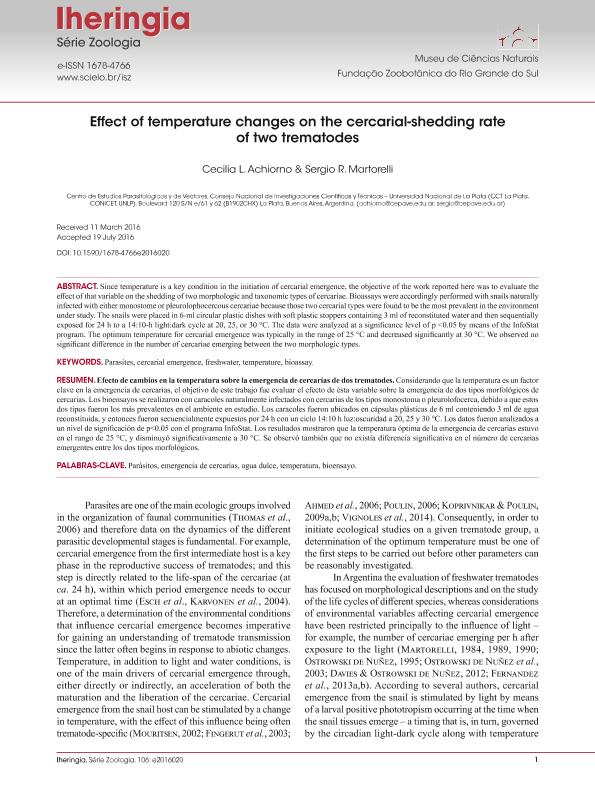Mostrar el registro sencillo del ítem
dc.contributor.author
Achiorno, Cecilia Lujan

dc.contributor.author
Martorelli, Sergio Roberto

dc.date.available
2018-06-18T20:55:44Z
dc.date.issued
2016-09
dc.identifier.citation
Achiorno, Cecilia Lujan; Martorelli, Sergio Roberto; Effect of temperature changes on the cercarial-shedding rate of two trematodes
; Fundaçao Zoobotanica Rio Grande Sul; Iheringia. Série Zoologia; 106; 9-2016; 1-5
dc.identifier.issn
0073-4721
dc.identifier.uri
http://hdl.handle.net/11336/49156
dc.description.abstract
Considerando que la temperatura es un factor clave en la emergencia de cercarias, el objetivo de este trabajo fue evaluar el efecto de ésta variable sobre la emergencia de dos tipos morfológicos de cercarias. Los bioensayos se realizaron con caracoles naturalmente infectados con cercarias de los tipos monostoma o pleurolofocerca, debido a que estos dos tipos fueron los más prevalentes en el ambiente en estudio. Los caracoles fueron ubicados en cápsulas plásticas de 6 ml conteniendo 3 ml de agua reconstituida, y entonces fueron secuencialmente expuestos por 24 h con un ciclo 14:10 h luz:oscuridad a 20, 25 y 30 °C. Los datos fueron analizados a un nivel de significación de p<0.05 con el programa InfoStat. Los resultados mostraron que la temperatura óptima de la emergencia de cercarias estuvo en el rango de 25 °C, y disminuyó significativamente a 30 °C. Se observó también que no existía diferencia significativa en el número de cercarias emergentes entre los dos tipos morfológicos.
dc.description.abstract
Since temperature is a key condition in the initiation of cercarial emergence, the objective of the work reported here was to evaluate the effect of that variable on the shedding of two morphologic and taxonomic types of cercariae. Bioassays were accordingly performed with snails naturally infected with either monostome or pleurolophocercous cercariae because those two cercarial types were found to be the most prevalent in the environment under study. The snails were placed in 6-ml circular plastic dishes with soft plastic stoppers containing 3 ml of reconstituted water and then sequentially exposed for 24 h to a 14:10-h light:dark cycle at 20, 25, or 30 °C. The data were analyzed at a significance level of p <0.05 by means of the InfoStat program. The optimum temperature for cercarial emergence was typically in the range of 25 °C and decreased significantly at 30 °C. We observed no significant difference in the number of cercariae emerging between the two morphologic types.
dc.format
application/pdf
dc.language.iso
eng
dc.publisher
Fundaçao Zoobotanica Rio Grande Sul

dc.rights
info:eu-repo/semantics/openAccess
dc.rights.uri
https://creativecommons.org/licenses/by-nc-sa/2.5/ar/
dc.subject
Bioassay
dc.subject
Cercarial Emergence
dc.subject
Freshwater
dc.subject
Parasites
dc.subject
Temperature
dc.subject.classification
Otras Ciencias Biológicas

dc.subject.classification
Ciencias Biológicas

dc.subject.classification
CIENCIAS NATURALES Y EXACTAS

dc.title
Effect of temperature changes on the cercarial-shedding rate of two trematodes
dc.title
Efecto de cambios en la temperatura sobre la emergencia de cercarías de dos trematodes
dc.type
info:eu-repo/semantics/article
dc.type
info:ar-repo/semantics/artículo
dc.type
info:eu-repo/semantics/publishedVersion
dc.date.updated
2018-06-18T13:31:25Z
dc.identifier.eissn
1678-4766
dc.journal.volume
106
dc.journal.pagination
1-5
dc.journal.pais
Brasil

dc.journal.ciudad
Porto Alegre
dc.description.fil
Fil: Achiorno, Cecilia Lujan. Consejo Nacional de Investigaciones Científicas y Técnicas. Centro Científico Tecnológico Conicet - La Plata. Centro de Estudios Parasitológicos y de Vectores. Universidad Nacional de La Plata. Facultad de Ciencias Naturales y Museo. Centro de Estudios Parasitológicos y de Vectores; Argentina
dc.description.fil
Fil: Martorelli, Sergio Roberto. Consejo Nacional de Investigaciones Científicas y Técnicas. Centro Científico Tecnológico Conicet - La Plata. Centro de Estudios Parasitológicos y de Vectores. Universidad Nacional de La Plata. Facultad de Ciencias Naturales y Museo. Centro de Estudios Parasitológicos y de Vectores; Argentina
dc.journal.title
Iheringia. Série Zoologia

dc.relation.alternativeid
info:eu-repo/semantics/altIdentifier/doi/http://dx.doi.org/10.1590/1678-4766e2016020
dc.relation.alternativeid
info:eu-repo/semantics/altIdentifier/url/http://ref.scielo.org/htj49m
Archivos asociados
